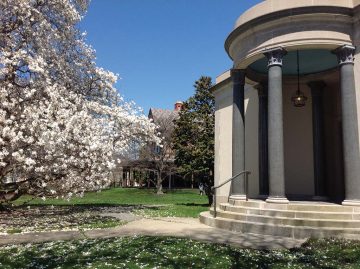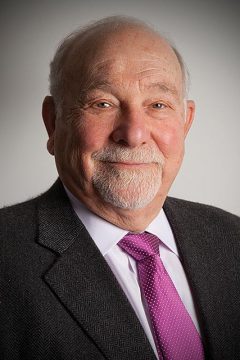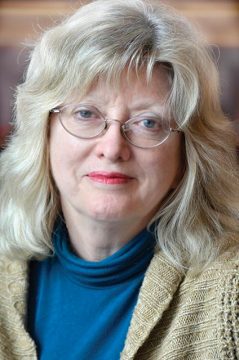In 2008, I launched the NetWorks project following several years of discussion with Umberto Crenca, founder of the alternative arts space AS220 in Providence, about documenting the work of contemporary Rhode Island artists.
I had been collecting, donating, and commissioning work from Rhode Island artists since the 1980s with my late wife, Helene. In 2005, the Rhode Island School of Design Museum mounted Chazans’ Choice, an exhibition celebrating gifts we had made to the museum over the previous twenty years. Tragically, my wife became critically ill and died as the show ended. Initiating the NetWorks project was a way for me to continue supporting the arts and artists in Rhode Island and provide tools to help them share their work with the world while continuing to learn about this highly creative community. Now, after more than one hundred video and photographic artist profiles, nine gallery and museum shows of NetWorks artists’ work, five catalogues and other content created that will live on through the internet, I have decided to conclude the project.
I want to thank Bert for his early collaboration; Scott Lapham for his steadfast portrait photography expertise; Richard Goulis for bringing forth the voices of so many artists through the videos; and Rhode Island PBS for making those videos accessible to all through their broadcasts. Thanks to curator Nancy Whipple Grinnell for brilliantly curating five shows of NetWorks artists’ work and to the Newport Art Museum for providing an ideal venue for those shows. I extend my gratitude to the Rhode Island School of Design Museum for hosting eight “world premieres” of the videos in their Metcalf Auditorium. Malcolm Grear Designers and Meridian Printing expertly created and produced the catalogues.
Most of all, I want to thank the extraordinary artists and artistic community of Rhode Island for the work they pursue each day and their contributions to our lives as creative catalysts. I am concluding the project not because of a paucity of local expertise to document or diminished interest but because it is time.
To ensure that the products of the project live on and remain accessible, I have partnered with the Providence arts project WaterFire. WaterFire will host NetWorks content on their website and promote its availability through social media. Their future plans include an arts center through which they plan to continue sharing NetWorks content.
This NetWorks journey has been highly gratifying for me. It has allowed me to meet and learn about many gifted and creative artists who have truly enriched my engagement with the arts as well as bringing me much pleasure. In parallel, it has always been my hope that NetWorks would enrich and expand the profiled artists’ opportunities and experiences. Finally, I want to thank Victoria Veh for lending her support, advice, and expertise to this project.
Joseph A. Chazan, M.D.
NetWorks: Artists for the 21st Century
The Newport Art Museum is pleased to host this final presentation of NetWorks, this time celebrating the artists of 2015–2016. While many in this group pursue traditional media—painting, printmaking, drawing, sculpture and ceramics—just as many others are mixing media or engaging with non-traditional materials. There is a focus on interdisciplinary concerns and an emphasis on creating a dialogue with the audience.
As I learned about these artists, I noted the importance of mentorship in several of their stories. Hank Gilpin was all set to pursue an MFA in his field of photojournalism until he took a woodworking course with Tage Frid at the Rhode Island School of Design. Frid convinced him that furniture design was his future and Gilpin continued to apprentice with him after graduation. Nicholas Benson initially learned from his father, John Benson, the art of handlettering and stone carving at The John Stevens Shop in Newport, Rhode Island. The senior Benson handed over the business to his son in 1993, and Nick has developed an international reputation for his lettering designs. Gail Whitsitt-Lynch learned to carve from her devoted mentor, sculptor Arnold Prince.
Many of the artists are seeking a connection. Ann Fessler’s creative drive is fueled by her project that seeks to tell the stories of birth mothers from the mid-20th century who gave up their babies. She has produced films, installations and a book. Ana Flores uses her sculptural installations to connect her audiences directly with their environment—or country in the case of her native Cuba. Mary Beth Meehan’s photojournalism connects us with the culture NetWorks: Artists for the 21st Century and often hidden community of a city. Reenie Barrow has traveled to the most remote island in the world—Easter Island—to visually capture the power of the monolithic human figures known as Moai.
The ceramic sculpture of Allison Newsome and the textile installations of Deborah Baronas both explore issues of environment and human interaction. With her sculpted earth mother (or father) figures, and symbols of hunting and gathering—corn, apples, water, wood, stone, grass—Newsome reminds us of the transition from the agrarian to an industrial landscape. Baronas, with her blending of art and history, succeeds in creating an emotional link between her viewers and the plight of unknown 19th century American workers.
For other artists, it is still primarily about the material. Jerry Ehrlich enthuses about rebar, which is the skeletal armature for poured concrete. From the construction site come amazingly graceful and yet incredibly robust sculptures. Paul Housberg turned from paint to glass, as he found its color more atmospheric; he now creates architectural structures from his fused and kiln formed glass. David Allyn believes it is important that the clay with which he creates his porcelain works of art is local, made by hand and fired at the Steel Yard, where he teaches. Sculptor Peter Diepenbrock brings his considerations of form and function to the metal, wood and glass with which he creates.
Fantasy and formal concerns are contrasted in the work of four artists. The sources for Jillian Barber’s sumptuously glazed imaginary ceramic animals and masks come partially from the pageantry and fairy tales of her native England, but also from her own dreams and meditation. The cats in Meredith Stern’s prints are also not based in reality, although their graphic quality recalls some German expressionist printmakers. Stern’s cats are more counterculture, advocating a cooperative lifestyle. Completely juxtaposed to Barber and Stern is the art of Barbara Owen and Lisa Perez, who diligently explore shapes, colors and dimensions. Owen is a painter who challenges the definition of painting by creating abstract drawings with colorfully painted strips, and then making them three-dimensional—or not. Shadows and illusions of color are side effects of Perez’s mostly wall-mounted cut-out grids and constructions.

Newport Art Museum, Courtesy of the Newport Art Museum.
Three professors of painting are included in the NetWorks group: David Frazer and Dennis Congdon of the Rhode Island School of Design and Richard Whitten of Rhode Island College. While Frazer includes Piero della Francesca’s frescoes in Arezzo among his inspirations, Congdon is intrigued with ancient Roman ruins, and Whitten references Italian Renaissance architecture. Their results are very different. Frazer paints improvisationally, his techniques based in abstract expressionism and collage. Congdon is more methodical; his canvases are filled with jumbled fragments of objects, a bit like a 21st century neon-colored Hieronymus Bosch. Whitten’s meticulously constructed environments bring to mind the space and perspective of MC Esher, with opulent color and gold leaf.
Four other artists seek out preferred subject matter. Recognized for her paintings of New England buildings, Gretchen Dow Simpson paints architectural fragments of light-filled exteriors and interiors. Painter and printmaker Brian Shure depicts people in public spaces, feeling strongly that these anonymous persons, on their way to or from a place, deserve as much respect and attention as the infrastructure that supports them. In Peter Marcus’ recent exhibition, “The New American Family,” he uses his technically magnificent printmaking process to explore the faces of his family. In a different manner, photographer and printmaker David DeMelim looks to capture in one work a juxtaposition/abstraction of human interaction in the built environment.
Once again, we are immensely appreciative of Dr. Joseph Chazan’s vision and dedication. NetWorks has served as an opportunity to connect with the working lives of many of the region’s respected artists, to celebrate the importance of arts in our society, and to appreciate the range of talent that exists here in Rhode Island. It has been a vital project.
Nancy Whipple Grinnell
Curator, Newport Art Museum

